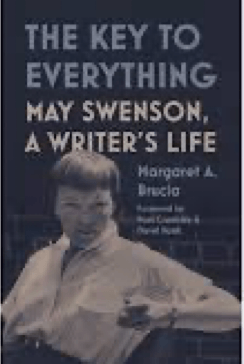






























































In many ways, I am the ideal reader for Margaret A. Brucia’s The Key to Everything: May Swenson, A Writer’s Life, as I knew little about her personal life and poetry, which blazed a modernist trail in mid-twentieth-century literary America. She was a friend and contemporary of Elizabeth Bishop, and met many leading lights, including the photographer Alfred Stieglitz and the writers James Baldwin and Richard Wright.
Some of Swenson’s best known and anthologized poems (by the Library of America, among others) are “Water Picture,” “Blue,” and “Question,” although Brucia most appreciates “The Centaur” (“The summer that I was ten–/Can it be there was only one summer that I was ten?”)
Brucia’s biography is more an account of Swenson’s life (1913 – 1989) than it is a work of literary criticism or textual analysis. Why this book distinguishes itself is that Brucia had access to many of Swenson’s diaries, especially those of her early life. Plus it has been years since a full length biography of Swenson has appeared, and those authors did not have access to Swenson’s diaries and personal correspondence, at least in this detail.
Swenson was born in Utah, of Swedish heritage, and grew up in the (Mormon) Church of Jesus Christ of Latter-day Saints, against which she rebelled in adolescence and adulthood, although she remained close to her parents and many siblings. (She wrote: “It’s not for me – religion. It seems like a redundancy for a poet.”) Swenson went to college in Utah, but in the 1930s found her way to New York and Greenwich Village—working odd jobs and struggling for recognition as a poet. 
In her twenties and thirties, Swenson went through numerous, often tumultuous love affairs (with both men and women), but she kept writing, both in her diaries and her poems; she also wrote a few short stories. Her words—“I have yet…to find my love”—speak for her romantic life and her poetry.
Brucia is at her best describing this coming of age for Swenson, who during the worst of the Depression often found herself running out of money. But Swenson persisted, always, and her breakthroughs were her work in the late 1930s – early 1940s for the Federal Writers Project, and in the 1950s with the publication of books of poetry, which launched her toward fame. Her poetry appeared sixty-one times in the New Yorker.
Brucia trained as a classicist. Her writing is scrupulously even-handed and detailed—without becoming pedantic—and she drives the narrative forward with judicious quotes from the diaries and letters. For example, Swenson wrote:
I have an ultimate dream—all else must be subordinate—especially my love.
In her poems and diaries, Swenson’s genius was to project her inner pleasures and turmoils onto America at mid-century, and allow her poetic self to speak for a nation. In her celebrated poem “Question” Swenson asks:
Body my house
my horse my hound
what will I do
when you are fallen
Where will I sleep
How will I ride
What will I hunt…
Readers who know of little of Swenson’s life will discover the story of a great American writer, while experts in the field will get their first look (from the diaries) of what Swenson was doing and thinking as she struggled on her long journey from a small Utah town to fame in literary America.
Princeton University Press has done an excellent job in publishing an elegant book for general readership that, at the same time, remains faithful to Swenson scholarship. Best of all, Brucia makes up her own mind about Swenson’s life, and for me this biography will remain the gold standard for many years in Swenson studies.
The post The Key to May Swenson appeared first on CounterPunch.org.
This post was originally published on CounterPunch.org.